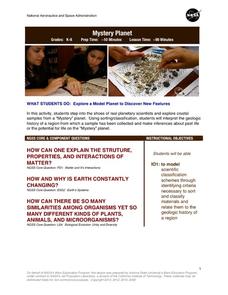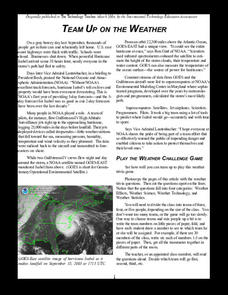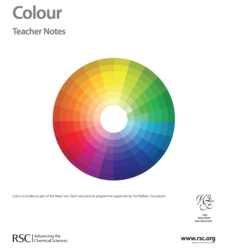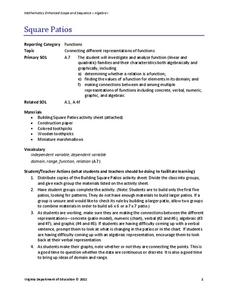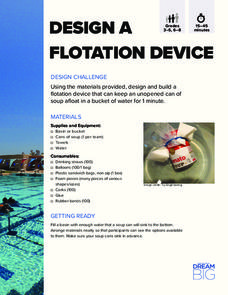Curated OER
Mother Nature Pattern Maker
Young scholars in a teacher education program enhance their awareness of patterns. They discover how to support their students in developing this skill in mathematical terms. They role play the role of a K-2 student and collect images...
Curated OER
Constructivist Theory
Students in a teacher education program are introduced to the constructivist theory. In grade level teams, they take their subject matter focus and create lesson plans related to the constructivist theory. They are graded with a rubric...
Curated OER
Developing Effective Instructional Plans and Assessments in Mathematics
Students in a teacher education program develop a technology based lesson plan. After the lesson plan is created, they develop their own performance assessment. They identify the characteristics of good assessment instruments and model...
Curated OER
Wilderness Classroom
Students visit an online website to complete animal and plant science activities. In this online education lesson, students visit the Wilderness Classroom website and follow the instructions and plans to learn about the science lessons...
NOAA
Mapping the Deep-Ocean Floor
How do you create a map of the ocean floor without getting wet? Middle school oceanographers discover the process of bathymetric mapping in the third installment in a five-part series of lessons designed for seventh and eighth graders....
NASA
Mystery Planet
What can one learn about a planet based on a small surface sample? Learners will explore artifacts from a mystery planet and see what they can determine about the planet based on the evidence in front of them.
Curated OER
Technology: Powerpoint, Lesson 2
Students create Powerpoint slide shows, entitled "All About Me." Their presentations include information about their families, hobbies, along with tables and charts. In addition, students use animation and sound in their projects.
Curated OER
Technology in the Early Education Classroom
Learners explore computers. They type their names and use different fonts. They create mini-posters using Kid Pix software and use the Oregon Trail software to discover the westward trek in United States history. They explore websites...
Curated OER
Wall of Respect
Students demonstrate respect. In this character education instructional activity, students discuss how to be respectful to adults and to peers. Students draw a picture of being polite or showing respect to a peer. Students place their...
Curated OER
A Visit to Hogwarts
Students collaborate in groups to read excerpts or entire selections from two Harry Potter books, use educational software to create concept maps detailing similarities and differences between first two Harry Potter books, and analyze...
Curated OER
Mini Golf
Students practice putting skills by hitting plastic golf balls to poly spots or cones placed on the gym floor. As students improve, the teacher places obstacles in the putting path for students to put around.
International Technology Education Association
Team Up on the Weather
There's a little bit about every aspect of weather in this trivia game. The lesson resource provides 36 questions and answers pertaining to four different topics related to weather: effects, science, technology, and statistics. Groups...
NASA
From Smoke Signals to Cell Phones: Tracing How Technologies Evolve
Explore the science of space exploration. Pupils consider technological advances in propulsion, communication, power, navigation, and imaging. They select one of these areas and create a timeline of historical progress that contributed...
Royal Society of Chemistry
Colour—Gifted and Talented Chemistry
Add a splash of color to your chemistry class! Science scholars discover the principles behind color through a wide variety of hands-on activities. Lessons include dyes, chromatography, and flame tests.
Statistics Education Web
Saga of Survival (Using Data about Donner Party to Illustrate Descriptive Statistics)
What did gender have to do with the survival rates of the Donner Party? Using comparative box plots, classes compare the ages of the survivors and nonsurvivors. Using the same method, individuals make conclusions about the gender and...
Virginia Department of Education
Square Patios
Build a patio from toothpicks and marshmallows to analyze functions! Learners look for patterns in the data as they create different size patios. As they discover patterns, they make connections between the different representations of...
Intel
Designer Genes: One Size Fits All?
In this STEM group of 10 activities, lesson two focuses on the question, "Just because we can, should we?" when considering genetically engineered food. Classes hear a scenario and, as young scientists and geneticists, must determine if...
Mathematics Vision Project
Module 7: Modeling with Functions
The sky's the limit of what you create when combining functions! The module begins with a review of transformations of parent functions and then moves to combining different function types using addition, subtraction, and multiplication....
California Department of Education
Name That Job!
Can you name the job that involves scholars, classes, and grades? If you guessed teacher, you just won a round of Name That Job! The second lesson in a five-part college and career readiness unit has career seekers team up and go head to...
Carnegie Mellon University
Consumer Preferences in Lighting
What is a watt? This tongue-twisting, mind-bending question and others are answered through this lesson on the different lighting options available. With the support of a PowerPoint, teach your physical science class about units of...
DiscoverE
Design a Flotation Device
Save the soup! Scholars devise a flotation device using straws, balloons, foam, corks, and other objects. A can of soup must stay afloat for at least a minute with this device—your dinner might depend on it!
DiscoverE
Human Arch
Sometimes, we all need somebody to lean on. Scholars create a human arch by leaning against each other. They consider different approaches to making the arch sturdier and stronger.
DiscoverE
Human Suspension Bridge
When is it okay to be suspended in school? When you're part of a human suspension bridge! Learners first model tension and compression in pairs. Once complete, they get together as a class to model a suspension bridge.
Kenan Fellows
Analyzing Speed from Different Modalities
Show us your moves. Using sensor equipment, scholars track the motion of different movements, such as jogging, skipping, or jump roping. They analyze velocity and acceleration and create graphs representing each movement.







